Abstract
The paper explores the propulsive power requirements and manoeuvring capabilities of a popular class of inland bulk carriers in Bangladesh. After the initial verification study, model-scale CFD simulations are performed in calm, open waters at different speeds to assess hull resistance. The resistance results are then extrapolated to full scale for calculating propulsion power requirements. Subsequently, manoeuvring simulations are performed using PMM motions to evaluate static drift, pure sway, and pure yaw scenarios to calculate manoeuvring coefficients. Following this, model-scale resistance simulations in restricted waters are performed to estimate the minimum power needed for propulsion in heavy monsoon currents based on common inland waterway dimensions in Bangladesh. Finally, full-scale simulations are performed in open water to investigate the scale effect on resistance (thus power) prediction. The study confirms that the installed power in the vessel is adequate for safe navigation within Bangladesh’s inland waters. Although model-scale CFD studies are generally unsuitable for resistance prediction, the study suggests that extrapolated results often offer conservative estimates for power prediction. In cases of resource limitation, these simulations can prove beneficial since conservative estimations somewhat ensure the vessel’s propulsion and manoeuvrability in extreme conditions.
1. Introduction
In the globalised world, roughly 90% of global goods are transported through shipping. However, almost all the goods that cross oceans by ships end up being transported in trucks through lands, ignoring the vast inland waterways in Europe and Asia. Like ocean-going ships, inland vessels are also relatively economical and environmentally friendly. Bangladesh, being a riverine country, also relies heavily on its rivers for the transportation of goods. Although attention has been somewhat limited to safety, economy, and efficiency in the past, with an improving economy, the country has started paying attention to such aspects following global trends. As part of the effort, this paper investigates the propulsion power requirement for a commonly used inland class vessel for carrying bulk goods.
While experimental and high-fidelity numerical studies are not uncommon for resistance and manoeuvring studies in restricted waters, most such studies focus on large seagoing vessels passing through coastlines or port channels. Among some of the previous works in the field, Carrica et al. [1] experimentally and numerically investigated the manoeuvrability of a KCS model in shallow waters. Tezdogan et al. [2] performed full-scale URANS simulations of vertical ship motions in shallow water to realise the effect of finite water depth on incoming waves. Liu et al. [3] investigated the DTC hull in shallow waters and observed the effects of water depth on ship speed and dynamic sinkage. Zeng et al. [4] studied the Wigley and KCS hulls to show that water depth and hull shape play important roles in a ship’s viscous resistance. They also demonstrated that conventional extrapolation methods for resistance do not apply to shallow waters and provided a different expression for predicting ship frictional resistance. Xu and Guedes Soares [5] and Xu et al. [6] experimentally studied the DTC model in shallow waters and developed non-linear implicit models and system-based identification models for the estimation of manoeuvring properties. Kim et al. [7] investigated a KCS model with an active rudder and body force-based propeller model using CFD to assess the influence of different water depths on ship manoeuvrability. Campbell et al. [8] studied the effect of drought and trim on ship resistance in confined waters and concluded that ship resistance can be reduced substantially in confined waters by trim adjustment. Islam and Guedes Soares [9] performed manoeuvring studies for the KCS model with appendages and compared changes in the ship’s manoeuvring derivatives while operating in open and restricted waters.
While the studies performed on seagoing vessels serve as a good reference, the relation of inland vessels with restricted waters is quite different due to their shape and design differences [10,11,12,13]. Differences arise due to inland vessels’ high prismatic coefficients, large flat bottoms, sharper edges [10], and waterway blockage effects and subsequent early flow detachments, recirculation zones, and boundary layer mixing [14]. Channel dimension, water depth, ship draught, and ship velocity have notable impacts on resistance and ship-generated waves [15]. Ship–ship interactions are also important in inland navigation [16,17].
Shallow water also affects the manoeuvring capability of ships, which may be critical in inland navigation [5,18,19]. The configuration of appendages also heavily influences the manoeuvring capabilities of such vessels [20,21]. Experimental studies also showed a notable increase in ship tactical diameter with reducing water depth [22]. According to Yang et al. [23], depending on the water depth, the ship’s tactical diameter may increase by up to 60%. Thus, dedicated studies on channel restriction impact on inland waters are important to ensure the operational safety of inland vessels.
However, in the case of inland waterways, both vessel design and type and channel restrictions vary notably from region to region. As such, studies performed for a particular region may not be equally applicable to other geographical areas. This study focuses on the propulsion power requirement from an inland bulk carrier designed and certified for operating in the waterways of Bangladesh. While a few previous studies have discussed different regulatory [24,25] and operational [26] aspects of Bangladesh inland waterways, dedicated studies for these waterways with high-fidelity models are scarce (if not non-existent). The present study attempts to discuss and demonstrate how channel restrictions in Bangladesh waterways affect vessel propulsion and manoeuvring requirements.
2. Method
The manoeuvring capabilities of an inland bulk carrier have been studied by performing PMM simulations. The OpenFOAM version 2006 has been studied for the study. The open water static drift simulations were performed with a heave and pitch-free motion. However, for the restricted water simulations, heave and pitch motions have been kept restricted. libsixDoFRigidBodyMotion library was used for the open water static drift simulations. Simulations were performed at a high Reynolds number with turbulent flows. Details on the solver, ship model, simulation setup, and resources are given in the following subsections.
2.1. The Solver
OpenFOAM is an open-source library that numerically solves a wide range of problems in fluid dynamics, from laminar to turbulent flows, with single and multi-phases. The solver has been elaborately described by Jasak [27]. The governing equations for the solver are the Navier–Stokes or momentum Equation (1) and the continuity Equation (2). In vector form, the Navier–Stokes and continuity equation are given by:
Here, is the velocity, is the pressure, is the dynamic viscosity, is the acceleration due to gravity and is the Laplace operator.
The volume of fluid (VOF) method is used to model the fluid as one continuum of mixed properties. This method determines the fraction of each fluid that exists in each cell, thus tracking the free surface elevation. The volume fraction is obtained by Equation (3):
where v is the velocity field, and α is the volume fraction of water in the cell, varying from 0 to 1, with 0 representing a cell full of air and 1 representing a cell full of water.
The Finite Volume Method (FVM) is used to discretise the governing equations. Time integration is performed using the first-order Eulerian scheme. For gradient and divergent terms, the Gauss upwind scheme is used. Pressure–velocity coupling is obtained through the PIMPLE algorithm, a combination of SIMPLE and PISO. All interpolation schemes in OpenFOAM, used for flux calculation in advection, operate with the MULES (Multidimensional Universal Limiter for Explicit Solution) based solver. For turbulence modelling, the two-equation SST k-ω model is used. The SST k-ω is the most commonly used turbulence model in ship hydrodynamic studies. Rough wall function has been used to account for the frictional resistance.
2.2. Ship Model and Channel Dimensions
The studied vessel is an inland bulk carrier that is in operation in the inland waterways of Bangladesh. It is a standard 82 m bulk carrier with a blunt bow and twin propellers. The vessel is designed to be 3000DWT and has a service speed of 10 knots. The vessel has twin propellers, each being propelled by an engine with 600 KW capacity. The design has been approved by The China Plan Approval Centre, RINA. Table 1 provides the specifications of the hull model, and Figure 1 shows its side and line view. Not all information related to the vessel is openly available. The vessel COG for the simulations has been considered at mid-ship and at ship draft. Both model- and full-scale simulations were performed for the present study. Model-scale simulations have been performed at 1:10 scale. Although full-scale simulations are preferable to avoid scaling-related uncertainties, considering resource limitations, model-scale simulations have been performed.

Table 1.
Specifications of the bulk carrier ship model.
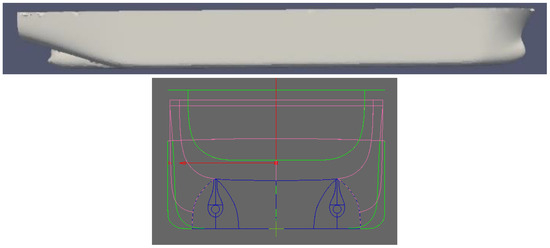
Figure 1.
Side view and lines of the 3000DWT inland bulk carrier vessel.
Inland waterways in Bangladesh come in different widths and depths depending on the location and season. Thus, vessels operate in both relatively open water and restricted water conditions. In this study, for restricted water simulations, a class III channel has been considered following the definition by the Bangladesh Inland Water Transport Authority (2023) [28]. The class III routes are feeder routes with regional importance. Such routes generally have a minimum vertical clearance of 7.62 m and a horizontal clearance of 30.48 m. For restricted water simulations, a similar configuration has been used.
2.3. Mesh
OpenFOAM mesh generation tools have been used for mesh generation. The initial simulation domain is created using blockMeshDict, with even resolution in the x and y directions and denser mesh resolution near the free surface in the vertical direction. The mesh is refined in the x–y direction using topoSetDict and refineMeshDict near the hull area. Six successive refinements are performed around the hull form to confirm the y+ criterion for capturing the boundary layer effect. For the drift simulations, the refinement areas are enlarged depending on the drift angle to accommodate the hull form. Next, snappyHexMeshDict is used to integrate the hull form into the simulation domain. The mesh resolution used for calm water simulations is around 4.0 million. The minimum cell size in the x and y directions in the mesh is 0.0125 m, and in the z direction is 0.01 m. Further, four layers have been included around the hull form with a minimum layer thickness of 0.0025 m.
For the domain size, general ITTC (2011) [29] guidelines are used, with one-and-a-half ship length in front of the bow, two-and-a-half ship lengths behind the stern, one ship length at each side, one ship length for depth, and half ship length above the free water surface. The simulation domain and mesh distribution in x–y and y–z planes, along with mesh distribution on the hull, are shown in Figure 2.
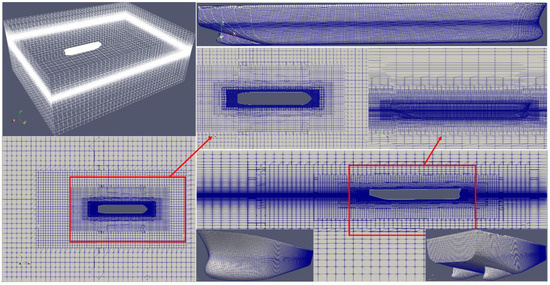
Figure 2.
General mesh assembly used in model-scale open water simulations; mesh distribution on ship hull, in the x–y plane (free surface), and the y–z plane (vertical surface). Red boxes indicate zoomed images.
In the case of restricted water simulations, considering the model-scale ratio of 1:10, the defined class III channel dimensions were reduced by 10 times while generating the simulation domain. Mesh for the restricted channel has been created using a draft-to-depth ratio of 2 (8.7 m) and a width of 3.8 m on each side (assuming a two-way channel). In the case of one-way traffic, the assumption is that the domain is split into two, and the vessel travels through one side. The simulation domains and mesh distribution are shown in Figure 3.
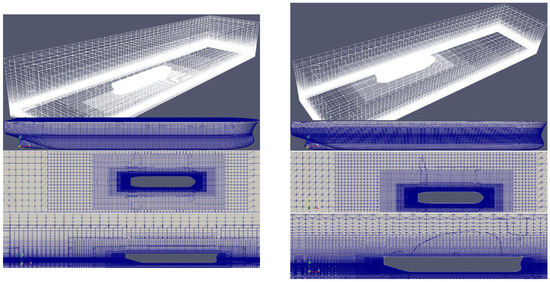
Figure 3.
General mesh assembly used in model-scale restricted water simulations assuming one-way (left) and two-way (right) traffic; mesh distribution on ship hull, in the x–y plane (free surface), and the y–z plane (vertical surface).
For drift simulations, the hull is rotated following the drift angle and then is integrated into the domain using snappyHexMesh. The average mesh resolution used for the drift simulations is around 4.2 million, whereas the mesh resolution used for sway and yaw simulations was around 4.0 million. The minimum cell size in the x and y directions in the mesh is 0.0125 m and in the z direction is 0.01 m. Further, four layers have been included around the hull form with a minimum layer thickness of 0.0025 m. The sway and yaw motions are applied by imposing rigid body motion on the simulation domain. For the restricted water simulations, the mesh topology and cell size are kept the same as in open water simulations. However, the refinements are extended both in the bottom and side sections to better capture the interaction with the sides. The general mesh assembly used in static drift simulations is shown in Figure 4.
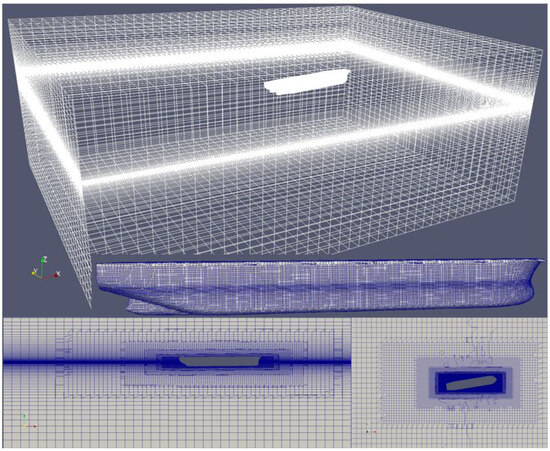
Figure 4.
General mesh assembly used in the model-scale static drift simulations, mesh distribution on hull surface, in the y–z and x–y plane.
A summary of different mesh resolutions used for different simulations is provided in Table 2.

Table 2.
Specifications of mesh resolution used in different sets of simulations.
2.4. Computational Resource
All the simulations have been performed on a laptop with an Intel Core i7 processor and 8 GB of RAM. The calm water and static drift simulations were run until 100 s (simulation time) for steady results, and each case took roughly 18 physical hours. Sway and yaw simulations were run for three steady cycles and the time varied between 18–30 h. Restricted water simulations took roughly 30 h, depending on the depth applied. The full-scale simulation with a half-domain took roughly 48 h in each case.
3. Results
The paper presents resistance and manoeuvring simulation results for an inland vessel. Initially, a verification study is presented for the resistance and drift simulations (Section 3.1). Next, model-scale simulations are presented for hull resistance in open water, followed by extrapolation of results to full scale (Section 3.2). After that, manoeuvring simulation, thus, static drift, pure sway, and pure yaw simulations are presented for open water, and manoeuvring derivatives are derived from the results (Section 3.3). Next, resistance simulations are performed in restricted waters considering the operating environment of the ship (Section 3.4). Finally, full-scale simulations are performed in open water to assess the impact of scaling on resistance results (Section 3.5). Considering the resistance simulation results, an estimation is provided for the propulsion power requirement of the ship and compared with the installed capacity (Section 3.6). A summary of the CFD simulation cases is provided in Table 3.

Table 3.
Summary of the simulated cases in the study.
3.1. Verification Study
For the verification study, simulations were performed using three different mesh resolutions with systematic refinements. For uncertainty quantification, both factor of safety [30] and correction factor-based [31] approaches have been used. A constant CFL-based discretidation approach was taken for the study [32]; that is, both grid and time steps were varied together while keeping the same CFL number. Since simulations were performed both in model and full scale, initially, uncertainty quantification is presented for model-scale results and in a later section for full-scale resistance simulation.
The model-scale simulations were performed for the static drift angle of 6 degrees. The drift simulation case allowed uncertainty quantification for the model both for force and moment measures. The simulations were performed with the heave and pitch-free motion. For the study, three mesh resolutions were used with a refinement ratio of 1.25. The mesh resolutions are shown in Table 4. The total mesh represents mesh resolution in millions of cells, and the cell size represents minimum cell size in the x, y, and z directions, respectively. The layers represent the number of layers added to the hull surface, and the minimum cell size is the cell size after the addition of the layers. The ratio represents the coarsening ratio of the mesh.

Table 4.
Mesh settings used for the uncertainty quantification for model-scale simulations.
The uncertainty analysis results are shown in Table 5. The table shows results for both the factor of safety and the correction factor-based uncertainty estimation approach. Uncertainty estimates are given for viscous and total drag force, lateral force, roll and yaw moments, and sinkage and trim values. The table shows that the simulations show both monotonous and oscillatory convergent cases and one divergent case. Following both the factor of safety and correction factor-based approaches, the highest uncertainty is observed for the roll moment prediction. Other than that, for most cases, the uncertainty is limited to around 5%. Assuming a target uncertainty bound of 5%, except the roll and yaw moment prediction, the rest of the results may be considered verified.

Table 5.
Uncertainty estimation results for the model-scale static drift simulations.
Unfortunately, to the authors’ best knowledge, no model experimental study or full-scale sea trial data is openly available for the vessel. The lack of experimental facilities limits such studies in Bangladesh. As for sea trial data, the information is owned by the vessel owner, and they are not generally willing to share the information. As such, no direct validation study could be performed for the vessel model. The low level of uncertainty in the results suggests that the estimations should be reliable.
Nevertheless, as an attempt for basic validation, a comparison table is included in Appendix A for the 6-degree drift results for the inland vessel against the KVLCC2 model. Although there are substantial differences between the two hull forms, one being a bulk carrier and another a tanker, they share some similarities in the bow shape. In the table, normalised surge and sway force and yaw moment results are compared.
3.2. Resistance Simulations in Open Waters
Initially, model-scale calm water simulations were performed for the ship model at three Froude numbers of 0.164, 0.182, and 0.2, corresponding to full-scale ship speeds of 9, 10, and 11 knots. The ship has a design speed of 10 knots for the inland waters of Bangladesh. A 1:10 scale ship model is simulated with a full hull (both starboard and port side), with the heave and pitch-free motion. Heave and pitch motions were kept free following the recent recommendations from the SIMMAN 2020 workshop. Other motions had to be kept restricted due to the absence of a heading control system in simulations. From the simulations, the ship’s encountered drag (both pressure and viscous force) and sinkage and trim are measured. For the calculation of the drag coefficient, two times the total surge force was divided by the water density, wetted surface area of the vessel, and square of the velocity (). The simulation results are shown in Table 6.

Table 6.
Model-scale calm water simulation results for the ship model in open water.
As expected, the results in Table 6 show gradually increasing ship resistance with increasing ship speed. The vessel also shows a higher sinkage value and reduction in negative trim angle with increasing speed. Hydrodynamic pressure distribution on the free surface and at the side of the hull at Fr. 0.182 is shown in Figure 5. As expected, the figure shows higher pressure oscillation at the ship’s bow and stern, with negligible pressure distribution in the parallel regions.

Figure 5.
Hydrodynamic pressure distribution on the free surface (above) around the hull and at the side (below) of the bulk carrier (model-scale) at Fr. 0.182.
Next, to assess the propulsion power requirement of the full-scale vessel, the model-scale results are extrapolated to full scale by applying the empirical formulation (ITTC-57) for viscous drag () and Reynolds scaling for pressure drag () [19,33]. The form factor (1 + k) of the vessel is computed to be 1.25 using MAXSURF. The total surge drag coefficient for any vessel is the sum of wave-making and viscous drag coefficient (). From the coefficient, the total drag force for a full-scale vessel may be calculated as . Here, is the wetted surface area, and is the corresponding velocity of the full-scale vessel. The required effective power is calculated as . For the power prediction, a quasi-propulsive coefficient of 0.65, 3.0% shaft and gearbox loss, and a 15% reduction to maintain the maximum continuous rating of the propeller are assumed [34]. The predicted results are shown in Table 7. The required installed power values have been rounded off.

Table 7.
Extrapolation of model-scale data to full scale and estimated propulsion power.
The predicted results show a power requirement of roughly 930 kW (1245 HP) for the design speed of 10 knots and 1470 kW (1970 HP) for 11 knots. Generally, in the inland waterways of Bangladesh, a maximum current speed of 6 knots is observed; thus, 10 knots speed is assumed to be sufficient for inland vessels. Thus, following the model-scale calm water simulations, an installed power of roughly 1000 kW should prove sufficient for attaining design speed without any current (considering propulsion power only without auxiliaries).
3.3. Manoeuvring Simulations in Open Waters
For the manoeuvring study, Planar Motion Mechanism (PMM) tests, that is, static drift, pure sway, and pure yaw simulations, are performed. All simulations are performed in open water on a model scale. For the static drift cases, the ship is free to heave and pitch, whereas, for pure sway and pure yaw simulations, all motions were kept restricted. After all the simulations, both static and dynamic manoeuvring derivatives are predicted from the results, and the general manoeuvring capability of the vessel is assessed. The lateral or sway force and vertical or yaw moment are converted to the lateral force coefficient and vertical moment coefficient by using the following equations.
3.3.1. Static Drift Simulations
Static drift simulations are performed at the ship design speed of 10 knots (1.627 m/s model scale). Simulations are performed for 0 to 15 degrees with 3-degree intervals. From the simulations, total drag resistance, sway force, and yaw moments are measured. Also, sinkage and trim are measured. From sway force and yaw moment, lateral force and vertical force coefficients are measured. The results are shown in Table 8. The force and moment time history for different drift angle simulations is also graphically shown in Figure 6. The time histories do not show a static line after initial oscillations due to sinkage and trim-free motion at a relatively high speed.

Table 8.
Open water static drift simulation results for the model-scale 3000DWT inland bulk carrier.
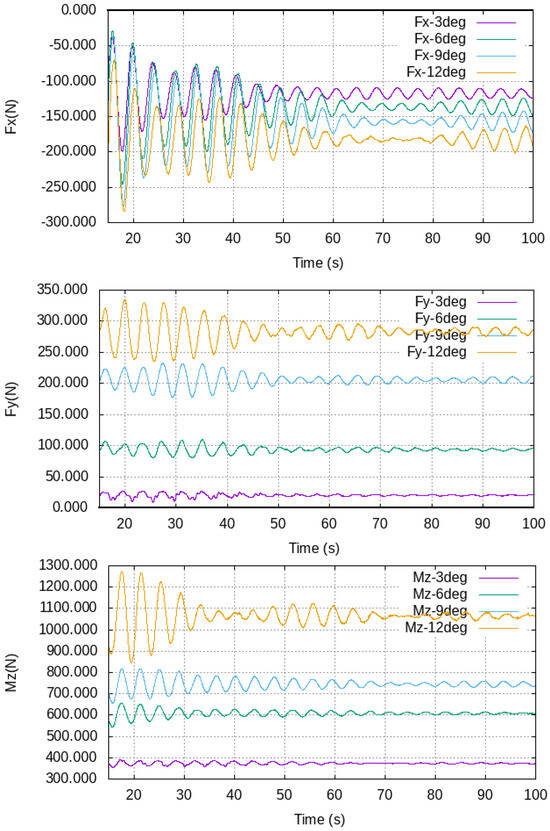
Figure 6.
Time history for surge (Fx) and sway (Fy) forces and yaw moment (Mz) for varying drift angles at Fr 0.182, respectively, from top to bottom.
The results show a gradual increase in the drag force with increasing drift angle. The viscous resistance results suggest that above a 6-degree drift, the viscous drag becomes somewhat constant and then starts to reduce beyond 9 degrees whereas, the pressure drag or wave-making resistance increases notably after a 3-degree drift. Both the lateral force and yaw moment show an almost linear increase with increasing drift angle. The sinkage shows a gradual increase whereas the trim remains somewhat constant. For vessels navigating in shallow waters, the change in sinkage becomes quite important since it will also influence the ship’s total drag and power requirement.
Hydrostatic pressure distribution on the free surface and on the hull for a 9-degree drift angle (Figure 7) shows asymmetric pressure distribution around the hull, causing the lateral force and yaw moment.
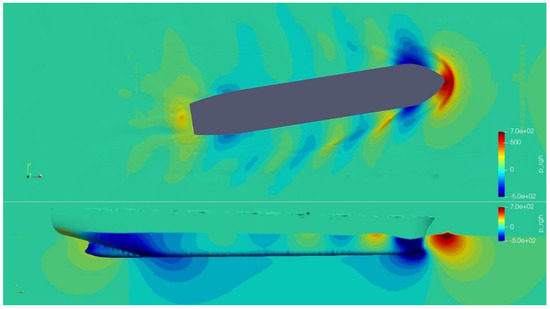
Figure 7.
Hydrostatic pressure distribution on the free surface around the hull and at the side of the hull (model scale) at a 9-degree drift angle and Fr. 0.182.
Although static drift simulations are principally performed for calculating static derivatives, the simulations also somewhat represent general manoeuvres during docking and undocking (with current). As such, power prediction for such cases also provides a rough estimate regarding power requirements during such manoeuvres. Table 9 provides the extracted full-scale power prediction for the vessel at design speed while manoeuvring at different drift angles. According to the results, the ship should manage to manoeuvre in drift conditions for angles up to 9 degrees at design speed. Beyond that, the ship will need to reduce speed.

Table 9.
Required power prediction for the bulk carrier during drift motions.
3.3.2. Pure Sway Simulations
For pure sway simulations, a fixed oscillating frequency of 0.53 rad/s was used with varying amplitude to match the required sway rate. In total, seven simulations have been performed with varying sway rates. The results (Table 10) show a gradually increasing trend in viscous and total drag with increasing sway rate. Both the normalised lateral force and yaw moment also show a gradually increasing trend, with the lateral force trend showing a steeper tangent. The force and moment have been normalised using Equations (4) and (5).

Table 10.
Open water pure sway simulation results for the model-scale 3000DWT inland bulk carrier.
The lateral force and yaw moment time history are also shown in Figure 8 for varying sway rates at Froude 0.182. With increasing sway amplitude, the results also show increasing force and moment. The change in pressure distribution on the free surface and the hull during sway motion is also shown in Figure 9. The figure shows a shift in positive bow pressure (red area at bow front) with shifting hull position.
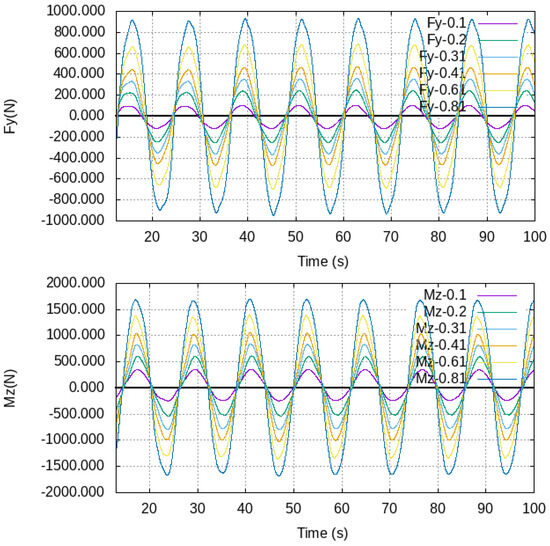
Figure 8.
Time history for sway (Fy) force and yaw moment (Mz) at model-scale simulations, for varying sway rates at Fr 0.182.
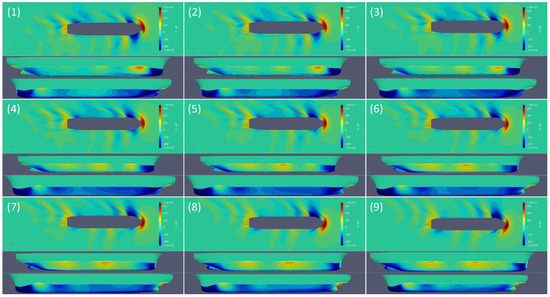
Figure 9.
Hydrostatic pressure distribution on the free surface (around the hull) and on the starboard and port side of the hull (model-scale simulations) at sway rate 0.81 and Fr. 0.182. Images 1–9 show flow field visualization with time interval of 0.2 s.
3.3.3. Pure Yaw Simulations
In the case of pure yaw simulations, varying yaw raters were achieved by keeping a constant yaw angle of 2° and varying oscillation frequency and lateral drift amplitudes. Since the pure yaw simulations were performed by applying motion on the simulation domain, a small yaw angle had to be applied to ensure minimum disturbance to the inflow. As can be seen from Table 11, due to a small angular variation, varying yaw rates have a marginal influence on viscous and total drag in the surge direction. However, Table 12 shows a notable change in lateral force and yaw moment coefficients with increasing yaw rate.

Table 11.
Simulation parameter settings and resistance results for pure yaw simulations of the bulk carrier.

Table 12.
Simulation results for lateral force and yaw moment for the bulk carrier with varying yaw rates.
The force and motion time history for simulations with different yaw rates are shown in Figure 10. For yaw simulations, different oscillation frequencies were used, which kept the angle constant; this is reflected in the time history. Hydrodynamic pressure distribution on the free surface and on the hull form for yaw simulations with the rate of 0.5 is also shown in Figure 11. The figure shows the change in pressure distribution on the free surface with changing vessel yaw.
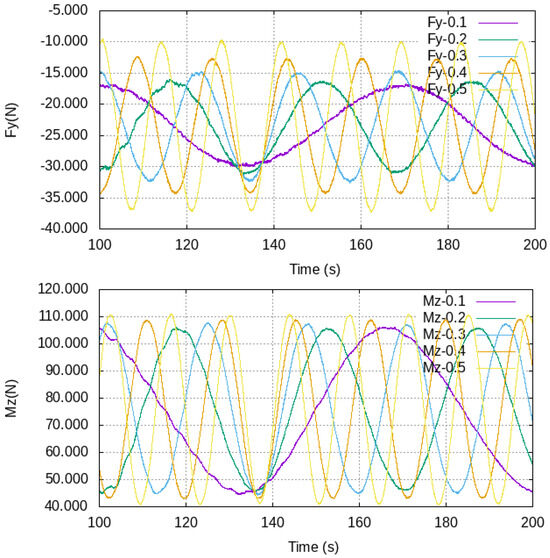
Figure 10.
Model-scale simulation time history for sway (Fy) force and yaw moment (Mz) for varying yaw rates at Fr 0.182.
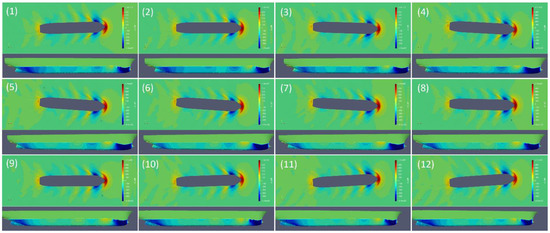
Figure 11.
Hydrostatic pressure distribution on the free surface (around the hull) and on the starboard and port side of the hull (model-scale simulations) at yaw rate 0.50 and Fr. 0.182. Images 1–12 represent flow field visualization for yaw simulation at 1 s time interval.
In the case of yaw derivatives, Yr and Nr, F′y and M′z should be estimated at minimum yaw angle amplitude, and and , F′y and M′z should be estimated at maximum yaw angle amplitude [35]. Thus, for increasing yaw rates, lateral force and yaw moment data are collected at zero yaw angle, and for increasing yaw acceleration rates, lateral force and yaw moment are calculated at maximum yaw angle. The results are shown in Table 12. The results show almost linearly increasing coefficient values with increasing yaw rate.
3.3.4. Manoeuvring Derivatives
The hydrodynamic derivatives represent the rate of change in force or moment with changing velocity or acceleration. These derivatives help to determine the stability and manoeuvrability of a vessel.
Following the PMM simulations, the hydrodynamic derivatives are predicted from lateral forces and yaw moments encountered by the vessel at different drift, sway, and yaw conditions. By applying polynomial curve fitting to the data for forces and moments as a function of drift angle β, sway rate v′max, yaw rate r′max, and yaw acceleration rate r′dot(max), the hydrodynamic derivatives or coefficients, Yv, Nv, , , , , , and are predicted from the slope of the curves. Among the derivatives, Yv and Nv are linear, and the rest are non-linear. The computed values are shown in Table 13.

Table 13.
Manoeuvring derivatives computed for the inland bulk carrier from model-scale PMM simulations.
According to theoretical hydrodynamics, the linear velocity derivatives represent damping forces and should have relatively small values. In terms of sign, Yv is expected to be negative, and Nv is expected to have a small positive or negative value. The results show a small positive value for both Yv and Nv.
Following the linear acceleration derivatives ( and ), sway added mass, the vessel shows relatively high added mass and damping forces in a lateral direction.
In the case of angular velocity derivatives, is expected to be a small positive or negative value, and is expected to be negative. For angular acceleration derivatives, is expected to be a small positive or negative, and is expected to be relatively large and negative. Following the results, the vessel seems to have relatively low angular stability. However, considering that the vessel being studied is a bulk carrier, it is not unexpected that it will have relatively poor manoeuvring capabilities.
3.4. Resistance Simulations in Restricted Waters
The bulk carrier being studied is expected to spend almost all of its lifetime in the inland waters of Bangladesh following the restrictions of the inland waterways. Such vessels are generally expected to operate in feeder routes with regional importance. Following the definition by Bangladesh Inland Water Transport Authority, common feeder routes in Bangladesh belong to class III. Such routes generally have a minimum vertical clearance of 7.62 m and a horizontal clearance of 30.48 m.
To realise the propulsion power required to voyage through such routes, simulations were performed replicating the channel restrictions, assuming both one-way and two-way traffic. In one-way traffic, the vessel is assumed to pass through the middle of the channel (Figure 12-left); however, in the case of two-way traffic, the vessel is assumed to pass through half of the channel width, being much closer to one side of the channel (Figure 12-right). Only channel depth and width restrictions are considered here, and ship-ship interaction due to passing ships has been ignored. All simulations are performed at the ship design speed of 10 knots.

Figure 12.
Simulation domain for restricted water simulations, vessel traveling through the middle of the waterway (left) and vessel traveling close to the side of the waterway (right).
For restricted water simulations, the simulation domain is revised following the channel geometry and model scale. The domain has been described in the mesh generation section. The simulation results are shown in Table 14. In the table, width 7.6 m indicates a one-way traffic assumption, and 7.6_side indicates a two-way traffic assumption. The h/T represents channel depth to ship draft ratio and shows a substantial influence on ship resistance, especially pressure resistance. Comparison between cases 1 and 4 also suggests notable influence due to vessel and riverbank interaction.

Table 14.
Calm water resistance simulation results for the inland bulk carrier in restricted waters.
Pressure distribution on the free surface and on the hull is also shown in Figure 13 for the vessel passing through a channel with depth to draft ratios of 2 and 1.5, respectively. The figure shows a notable influence of the domain bottom on the hull in case of shallower clearance.
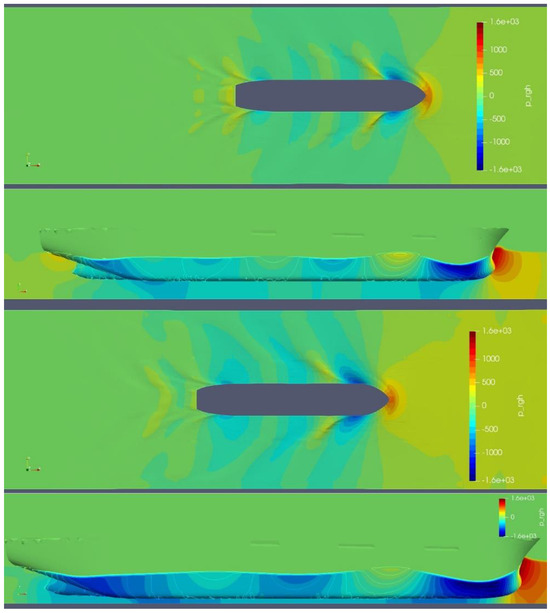
Figure 13.
Hydrodynamic pressure distribution on the water surface and on the hull in restricted simulations (model scale). The top image represents a simulation with a depth-to-draft ratio of 2.0, and the bottom image represents 1.5. Both simulations were performed at the ship design speed of 10 knots.
The extrapolated results for power requirements are shown in Table 15. For the restricted waters, viscous drag coefficients were calculated by including a term for shallow water effect [36], {(1 + k) + }. The results suggest that the vessel will only be able to maintain its design speed (10 knots) until h/T = 4, and the vessel will have to reduce speed for lower clearance. The vessel speed will also be reduced in case of navigating through channels with narrow width. However, it cannot be lower than six knots since that is the expected monsoon season current in the inland waterways of Bangladesh. Thus, ensuring higher propulsion capacity compared to open water is essential to ensure a vessel’s propulsion capability while passing through restricted waters with current.

Table 15.
Extrapolated full-scale power requirement for the vessel while navigating through inland restricted waters.
An important aspect of restricted water simulations is the study of effects related to hull wake, propeller wash, the influence of the number of propellers, current, and reflected waves in the shallow and narrow channel. However, the present study mostly focused on resistance prediction and studies related to these influences were ignored.
3.5. Scale Effect on Resistance Prediction and Propulsion Power Prediction
One major advantage of RANS simulation over other time domain simulation approaches is its ability to predict viscous forces with reasonable reliability. However, as discussed in several previous publications [19,33], while extrapolating model scale RANS results to full scale for resistance prediction, the viscous resistance predicted by the RANS solver is completely ignored, and empirical formulation is used instead. As such, the extrapolated values often provide conservative or optimistic estimations of total resistance.
While conservative estimates increase production cost, optimistic estimations will limit the vessel from attaining design speed. As such, it is important to realise the scale effect for the present case study and ensure that the estimates are not too optimistic. Thus, in this section, open water resistance simulations are repeated at full scale for varying ship speeds to assess propulsion power requirements for the vessels, and comparisons are made to the extrapolated model-scale results.
Initially, a grid dependency analysis was performed for full-scale resistance simulation using three grid resolutions to estimate the numerical uncertainty of results. To reduce computational cost, all three simulations were performed for the half hull. The mesh configurations used for the simulations are shown in Table 16, and the uncertainty estimation results are shown in Table 17. Due to scaling, slightly larger cell sizes could be applied, maintaining similar (to model scale) y+ values. The mesh distribution is shown in Figure 14.

Table 16.
Mesh settings used for the uncertainty quantification for full-scale simulations (half hull).

Table 17.
Uncertainty estimation results for the full-scale calm water simulations (half hull).
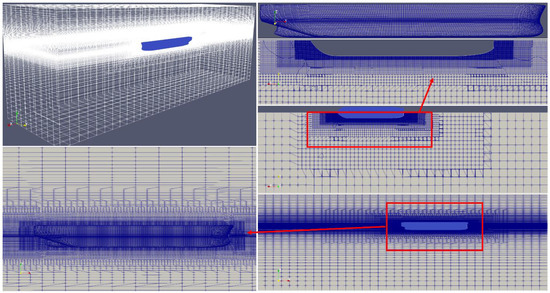
Figure 14.
General mesh assembly used in the full-scale open water simulations, mesh distribution on hull surface, y–z, and x–y plane.
The uncertainty estimation suggests that uncertainty in pressure resistance prediction is relatively higher compared to uncertainty in viscous resistance prediction. However, the total corrected uncertainty for the simulations remains low in both approaches.
After the verification study, the moderate mesh resolution of 4.03 million was used for half-hull simulations. For assurance, simulations for two vessel speeds were also repeated with a full hull that showed negligible influence on resistance prediction due to consideration of symmetry. Full-scale simulations also had to be performed in static conditions to reduce mesh dependency and ensure stability. Managing vessel motion through mesh morphing in case of full-scale simulation, while maintaining sufficient mesh resolution becomes very challenging in OpenFOAM. Thus, a compromise had to be made in this case.
Open water full-scale resistance simulation results for the bulk carrier are shown in Table 18, for vessel speed varying from 6 to 12 knots. All simulations were performed at the design draft with a static hull. As expected, the vessel shows a notable increase in ship resistance with increasing speed. After 10 knots, the ship resistance increases substantially with each unit increase in speed. The pressure distribution on the hull surface at 10 knots speed is shown in Figure 15.

Table 18.
Open water full-scale simulation results for the inland bulk carrier.
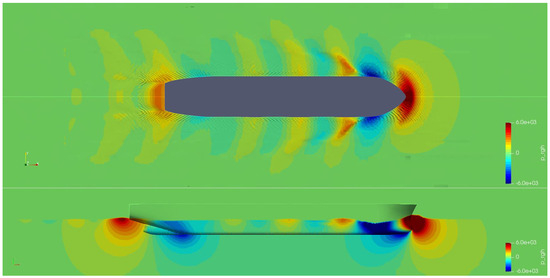
Figure 15.
Pressure distribution on the water surface and at the side of the hull at steady condition of full-scale simulation at 10 knots speed in open waters.
The resistance coefficient values and the required installed power prediction are shown in Table 19. While the theoretical drag coefficient decreases with increasing speed (thus Reynolds number), the simulation results show a notable increase from six to eight knots speed. Then, simulations show slight oscillations in results for viscous drag coefficients from 8 to 12 knots. The fact that the vessel was simulated with all degrees of freedom restricted might have some effect here. However, the relative change in viscous drag coefficient remains small with changing speed, both in the case of theoretical and full-scale CFD results.

Table 19.
Power prediction for the inland bulk carrier from open water full-scale simulations.
A relative comparison among the required installed power predicted by the model and full-scale simulation (shown in Figure 16) suggests that scaling effect remains relatively small for this vessel for low-speed cases. However, with increasing vessel speed, the model-scale results provide optimistic estimates. However, it should also be admitted that some influence here might also come from static hull simulations in the case of full scale. Nevertheless, for this study, it may be concluded that extrapolated model-scale simulation results should prove sufficient to make an estimate for the propulsion power requirement for this vessel.
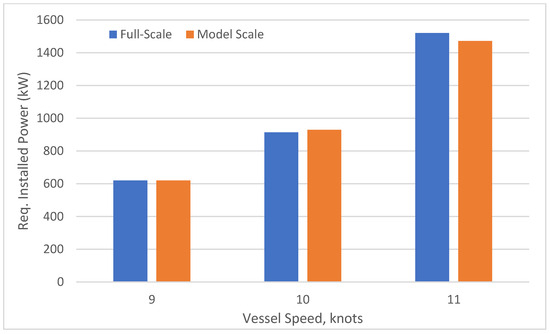
Figure 16.
Relative comparison between the propulsion power predicted by extrapolated model-scale and full-scale simulation results for three-vessel speeds.
3.6. Final Recommendation for Propulsion Power Requirement
Apart from studying the manoeuvring capabilities of the bulk carrier, the major target of the study is to assess the propulsion power requirement of the vessel to maintain design speed during its routine operation within the inland waterways of Bangladesh. Following model- and full-scale open water simulations, for maintaining a design speed of 10 knots, 1000 kW should prove sufficient (excluding auxiliary power requirements).
However, for drifting manoeuvres (during docking, undocking, and steering) of relatively higher amplitudes, slightly higher power requirements are observed. With an installed capacity of 1000 kW, the vessel would be able to manoeuvre with up to 6 degrees. Whereas, for 9 degrees, roughly 1200 kW would be necessary.
Finally, considering channel restrictions (both in terms of width and depth), to maintain the design speed in a typical class III waterway in Bangladesh, roughly 1500 KW power should be necessary. However, as observed by Islam et al. (2021) [19], model-scale simulations generally tend to provide notably conservative (up to 20%) predictions for restricted waters. As such, the required power in the practical case might be slightly lower. Thus, for average channel depth and width, an installed capacity of 1200 kW should prove sufficient, excluding auxiliary power requirements.
The recommended value also matches the recommended value by the class society and the current installed capacity of the vessel.
4. Conclusions
The study predicts the propulsion power requirement and manoeuvring capabilities of a bulk carrier designed for the inland waterways of Bangladesh. The study performs both open and restricted water simulations to ensure that the vessel will manage to voyage at design speed in different operating conditions. Scale effects on power prediction are also investigated to avoid optimistic prediction. Manoeuvring derivatives are also calculated for the vessel through PMM simulations in open water to investigate its manoeuvring capabilities.
Initial resistance studies in open waters suggest that an installed capacity of 1000 kW should prove sufficient to attain and operate at design speed at fully loaded (design draft) conditions. However, manoeuvring simulations (static drift) suggest a higher power requirement for performing manoeuvres at design speed. After that, restricted water simulations also show a substantial increase in power requirement for voyages through relatively narrow and shallow waters. This is especially important since the vessel needs sufficient capacity to propel through restricted waters while facing monsoon currents. Finally, full-scale simulations are used to confirm that the model-scale predictions were not optimistic. After all simulations, an installed capacity of 1200 kW is recommended, excluding auxiliary power requirements. The value also confirms the current installed capacity of the vessel in operation.
The manoeuvring simulations suggested relatively poor manoeuvring chrematistics of the vessel, which is somewhat common in the case of bulk carriers. The vessel’s manoeuvring performance is expected to deteriorate further in case of operating through restricted waters [22]. Thus, ensuring sufficient propulsion power installation is essential to ensure safe operation of the vessel.
The presented study, in a sense, is a validation study that confirms the traditional design approaches used in Bangladesh for vessel design and propulsion power prediction. While most shipyards (in Bangladesh) still rely on experience and low-fidelity tools for power prediction, this study demonstrates a systematic approach for powering study using a high-fidelity open-source tool. The study aims to be a reference for such relatively small shipyards for future powering studies.
However, the study is not without limitations. While resistance simulations have been performed for restricted waters, manoeuvring capabilities of the ship have not been assessed in similar operating conditions. Furthermore, for restricted water simulations, only a bare hull has been considered, ignoring the propeller effect. Due to resource limitations, such sophisticated simulations could not be attempted in the present study and are expected to be addressed in future studies.
Author Contributions
Conceptualisation, H.I. and M.M.R.; methodology, H.I. and M.M.R.; software, H.I.; validation, H.I. and M.M.R.; formal analysis, H.I. and M.M.R.; writing—original draft preparation, H.I.; writing—review and editing, M.M.R.; visualisation, H.I. All authors have read and agreed to the published version of the manuscript.
Funding
This research received no external funding.
Institutional Review Board Statement
Not applicable.
Informed Consent Statement
Not applicable.
Data Availability Statement
Data generated within the study has been presented in the paper. Data related to the ship design and sea trial are not publicaly available.
Conflicts of Interest
The authors declare no conflicts of interest.
Appendix A
The following table shows comparison results for static drift simulation results at 6 degrees between the KVLCC2 and the inland bulk carrier model. The KVLCC2 results presented here were also generated using OpenFOAM. The KVLCC2 comparison data were taken from [37], where the OpenFOAM results were validated against experimental and other CFD data. Comparison is provided for normalised surge and sway force and yaw moment results. For normalisation of results, the equations used in [37] have been used.

Table A1.
Tanker and the inland bulk carrier model.
Table A1.
Tanker and the inland bulk carrier model.
| Surge, F′x | Sway, F′y | Yaw, M′z | |
|---|---|---|---|
| KVLCC2 | 4.90 × 10−3 | 0.025 | 0.014 |
| BD-vessel | 6.19 × 10−3 | 0.02045 | 0.016 |
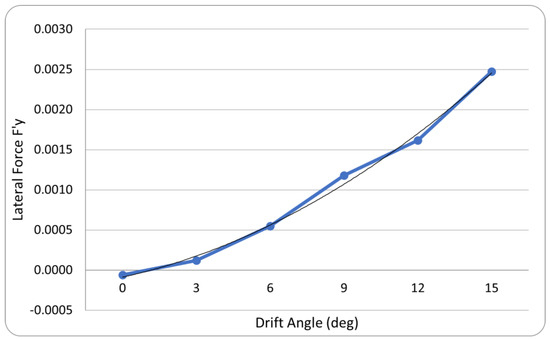
Figure A1.
Prediction of lateral force coefficient for varying drift angles at design speed (Fr 0.182).
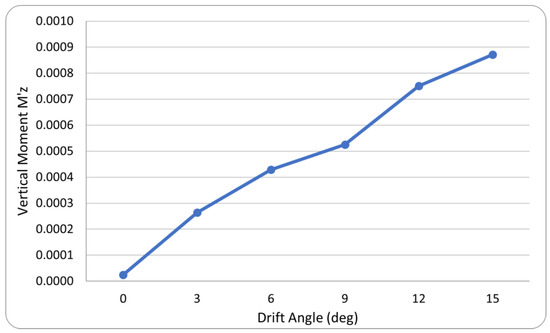
Figure A2.
Prediction of Yaw moment coefficient for varying drift angles at design speed (Fr 0.182).
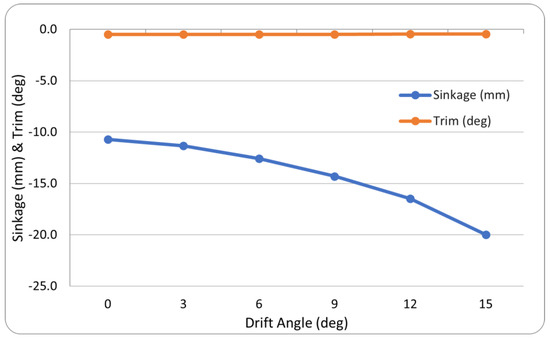
Figure A3.
Prediction of sinkage and trim for varying drift angles at design speed.
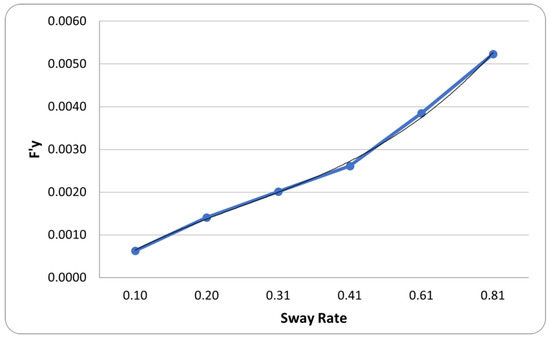
Figure A4.
Prediction of lateral force coefficient for varying sway rates at design speed (Fr 0.182).
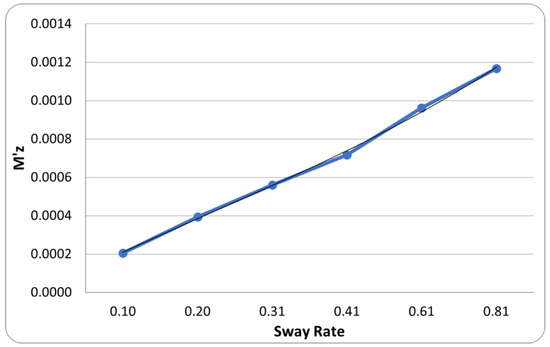
Figure A5.
Prediction of yaw moment coefficient for varying sway rates at design speed (Fr 0.182).
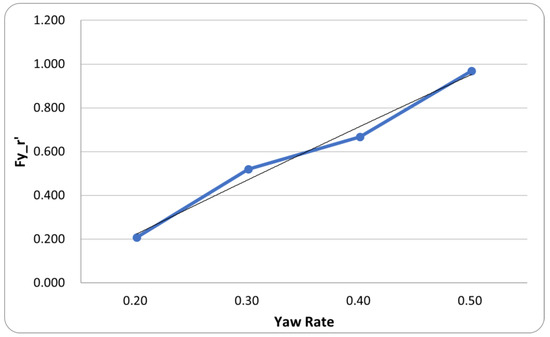
Figure A6.
Prediction of sway force coefficient for varying yaw rates at design speed (Fr 0.182).
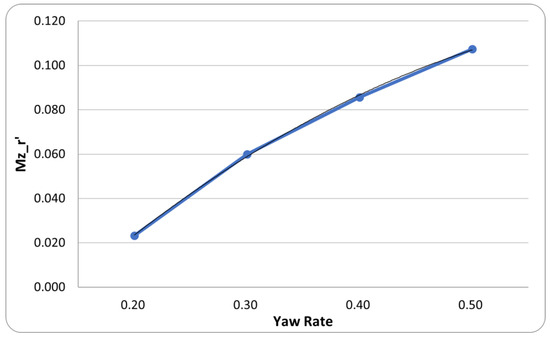
Figure A7.
Prediction of yaw moment coefficient for varying yaw rates at design speed (Fr 0.182).
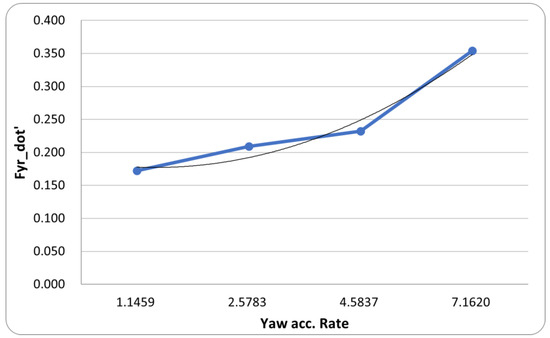
Figure A8.
Prediction of sway force coefficient for varying yaw acceleration rates at design speed (Fr 0.182).
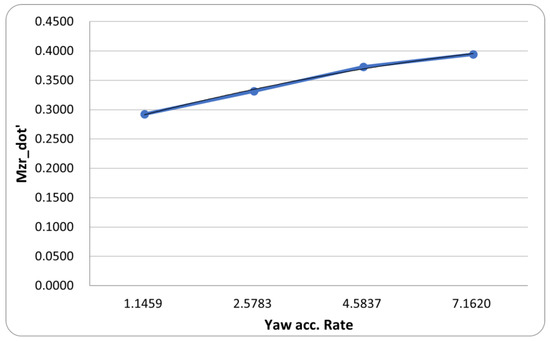
Figure A9.
Prediction of yaw moment coefficient for varying yaw acceleration rates at design speed (Fr 0.182).
References
- Carrica, P.M.; Mofidi, A.; Eloot, K.; Delefortrie, G. Direct simulation and experimental study of zigzag maneuver of KCS in shallow water. Ocean Eng. 2016, 112, 117–133. [Google Scholar] [CrossRef]
- Tezdogan, T.; Incecik, A.; Turan, O. Full-scale unsteady RANS simulations of vertical ship motions in shallow water. Ocean Eng. 2016, 123, 131–145. [Google Scholar] [CrossRef]
- Liu, Y.; Zou, Z.; Zou, L.; Fan, S. CFD-based numerical simulation of pure sway tests in shallow water towing tank. Ocean Eng. 2019, 189, 106311. [Google Scholar] [CrossRef]
- Zeng, Q.; Hekkenberg, R.; Thill, C. On the viscous resistance of ships sailing in shallow water. Ocean Eng. 2019, 190, 106434. [Google Scholar] [CrossRef]
- Xu, H.T.; Guedes Soares, C. Manoeuvring Modelling of a Containership in Shallow Water based on Optimal Truncated Nonlinear Kernel-based Least Square Support Vector Machine and Quantum-Inspired Evolutionary Algorithm. Ocean Eng. 2020, 195, 106676. [Google Scholar] [CrossRef]
- Xu, H.T.; Hinostroza, M.A.; Wang, Z.; Guedes Soares, C. Experimental investigation of shallow water effect on vessel steering model using system identification method. Ocean Eng. 2020, 199, 106940. [Google Scholar] [CrossRef]
- Kim, D.; Tezdogan, T.; Incecik, A. Hydrodynamic analysis of ship manoeuvrability in shallow water using high-fidelity URANS computations. Appl. Ocean Res. 2022, 123, 103176. [Google Scholar] [CrossRef]
- Campbell, R.; Terziev, M.; Tezdogan, T.; Incecik, A. Computational fluid dynamics predictions of draught and trim variations on ship resistance in confined waters. Appl. Ocean Res. 2022, 126, 103301. [Google Scholar] [CrossRef]
- Islam, H.; Guedes Soares, C. Estimation of hydrodynamic derivatives of an appended KCS model in open and restricted waters. Ocean Eng. 2022, 266, 112947. [Google Scholar] [CrossRef]
- Mucha, P.; el Moctar, B.O. Dettmann Thorsten, and Matthias Tenzer. Inland waterway ship test case for resistance and propulsion prediction in shallow water. Ship Technol. Res. 2017, 64, 106–113. [Google Scholar] [CrossRef]
- Quadvlieg, F.; Willemsen, C.; de Boer, W. Manoeuvring Simulation Models for Inland Ships. In Proceedings of the 5th International Conference on Ship Manoeuvring in Shallow and Confined Water (MASHCON), Ostend, Belgium, 19–23 May 2019; pp. 315–326. [Google Scholar]
- Bedos, A.; Tonelli, R. An Extensive Experimental Investigation of Shallow- and ConfinedWater Effects on the Manoeuvring Forces of a 110 m Inland Ship. In Proceedings of the 6th International Conference on Ship Manoeuvring in Shallow and Confined Water (MASHCON), Glasgow, UK, 22–26 May 2022; pp. 1–9. [Google Scholar]
- MASHCON, 2009–2022. Available online: https://www.waterbouwkundiglaboratorium.be/en/conferences/6th-mashcon-port-manoeuvres-2022 (accessed on 1 October 2023).
- Rzeszutko, J.; Lahbib, Z.; el Moctar, O. Shallow water effects on an inland waterway vessel under steady drift conditions. In Proceedings of the 24th Numerical Towing Tank Symposium October 2022, Zagreb, Croatia, 15–18 October 2022; pp. 138–144. [Google Scholar]
- Du, P.; Ouahsine, A.; Sergent, P.; Hu, H. Resistance and wave characterizations of inland vessels in the fully-confined waterway. Ocean Eng. 2020, 210, 107580. [Google Scholar] [CrossRef]
- Zhou, X.Q.; Sutulo, S.; Guedes Soares, C. Ship-Ship hydrodynamic interaction in confined waters with complex boundaries by a Panelled Moving Patch Method. RINA Int. J. Marit. Eng. 2016, 158, A21–A30. [Google Scholar] [CrossRef]
- Wnęk, A.D.; Sutulo, S.; Guedes Soares, C. CFD analysis of ship-to-ship hydrodynamic interaction. J. Mar. Sci. Appl. 2018, 17, 21–37. [Google Scholar] [CrossRef]
- Zhou, X.Q.; Sutulo, S.; Guedes Soares, C. A paving algorithm for dynamic generation of quadrilateral meshes for online numerical simulations of ship manoeuvring in shallow water. Ocean Eng. 2016, 122, 10–21. [Google Scholar] [CrossRef]
- Islam, H.; Guedes Soares, C.; Liu, J.; Wang, X. Propulsion power prediction for an inland container vessel in open and restricted channel from model and full-scale simulations. Ocean Eng. 2021, 229, 108621. [Google Scholar] [CrossRef]
- Liu, J.; Hekkenberg, R.; Rotteveel, E.; Hopman, H. Literature review on evaluation and prediction methods of inland vessel manoeuvrability. Ocean Eng. 2015, 106, 458–471. [Google Scholar] [CrossRef]
- Liu, J. Impacts of Rudder Configuration on Inland Vessel Manoeuvrability. Ph.D. Thesis, Delft University of Technology, Delft, The Netherlands, 2017. [Google Scholar]
- Vantorre, M.; Eloot, K.; Delefortrie, G.; Lataire, E.; Candries, M.; Verwilligen, J. Maneuvering in Shallow and Confined Water. In Encyclopedia of Maritime and Offshore Engineering; John Wiley & Sons Ltd.: Hoboken, NJ, USA, 2017; pp. 1–17. [Google Scholar]
- Yang, Y.; Chillcce, G.; el Moctar, O. Mathematical modeling of shallow water effects on ship maneuvering. Appl. Ocean Res. 2023, 136, 103573. [Google Scholar] [CrossRef]
- Rahman, S.; Zakaria, N.M.G. Development of an Energy Efficiency Design Index for Inland Vessels of Bangladesh. J. Mar. Sci. Appl. 2020, 19, 275–282. [Google Scholar] [CrossRef]
- Islam, M.R.; Barnil, M.; Haque, A.K.M.; Rahman, M.; Hossain, K. Applicability of Current Statutory Rules for Stability Requirements of Bangladesh Inland Passenger Vessels. J. Ship Res. 2022, 66, 219–230. [Google Scholar] [CrossRef]
- Rahaman, M.M.; Islam, H.; Zakaria, N.M.G.; Alamgir, M.Z. Studying Static Derivatives of an Inland Bulk Carrier in Open and Restricted Waters using OpenFOAM. J. Marit. Res. 2022, XIX, 31–38. [Google Scholar]
- Jasak, H. OpenFOAM: Open Source CFD in research and industry. Int. J. Nav. Archit. Ocean Eng. 2009, 1, 89–94. [Google Scholar]
- Bangladesh Inland Water Transport Authority. Available online: http://www.biwta.gov.bd (accessed on 1 July 2023).
- ITTC. ITTC-Recommended Procedures and Guidelines: Practical Guidelines for Ship CFD Application. 2011. Available online: https://ittc.info/media/1357/75-03-02-03.pdf (accessed on 1 July 2023).
- Celik, I.B.; Ghia, U.; Roache, P.J.; Freitas, C.J.; Coleman, H.; Raad, P.E. Procedure for Estimation and Reporting of Uncertainty Due to Discretization in CFD Applications. J. Fluids Eng. Trans. ASME 2008, 130, 078001. [Google Scholar]
- Stern, F.; Wilson, R.; Shao, J. Quantitative V&V of CFD Simulations and Certification of CFD Codes. Int. J. Numer. Methods Fluids 2006, 50, 1335–1355. [Google Scholar]
- Islam, H.; Guedes Soares, C. Assessment of uncertainty in the CFD simulation of the wave-induced loads on a vertical cylinder. Mar. Struct. 2021, 80, 102088. [Google Scholar] [CrossRef]
- Islam, H.; Guedes Soares, C. Head wave simulation of a KCS model using OpenFOAM for the assessment of sea-margin. J. Offshore Mech. Arct. Eng. 2022, 144, 1–24. [Google Scholar] [CrossRef]
- Marine Insight. 2019. Available online: https://www.marineinsight.com/naval-architecture/power-requirement-ship-estimated/ (accessed on 1 July 2023).
- Lewis, E. Principles of Naval Architecture; The Society of Naval Architects and Marine Engineers: Jersey City, NJ, USA, 1988. [Google Scholar]
- Millward, A. The effect of water depth on hull form factor. Int. Shipbuild. Prog. 1989, 36, 283–302. [Google Scholar]
- Islam, H.; Guedes Soares, C. A CFD study of a ship moving with constant drift angle in calm water and waves. In Progress in Maritime Engineering and Technology; Guedes Soares, C., Santos, T.A., Eds.; Taylor & Francis Group: London, UK, 2018; ISBN 978-1-138-58539-3. [Google Scholar]
Disclaimer/Publisher’s Note: The statements, opinions and data contained in all publications are solely those of the individual author(s) and contributor(s) and not of MDPI and/or the editor(s). MDPI and/or the editor(s) disclaim responsibility for any injury to people or property resulting from any ideas, methods, instructions or products referred to in the content. |
© 2024 by the authors. Licensee MDPI, Basel, Switzerland. This article is an open access article distributed under the terms and conditions of the Creative Commons Attribution (CC BY) license (https://creativecommons.org/licenses/by/4.0/).